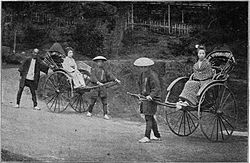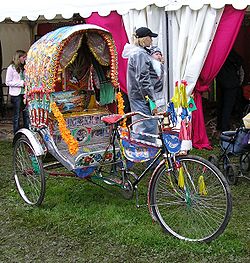Rickshaw
From Wikipedia, the free encyclopedia
For the photojournalist, see Rick Shaw.
Pulled rickshaw, Japan, about 1897
Cycle rickshaw Bangladeshi style Rickshaw at Sweden.
An auto rickshaw (tuk-tuk) in Nairobi
Pulled rickshaws created a popular form of transportation, and a source of employment for male laborers, within Asian cities in the 19th century. Their popularity declined as cars, trains and other forms of transportation became widely available.
Auto rickshaws are becoming more popular in some cities in the 21st century as an alternative to taxis because of their low cost.
Etymology
The word rickshaw originates from the Japanese word jinrikisha (人力車, 人 jin = human, 力 riki = power or force, 車 sha = vehicle), which literally means "human-powered vehicle".[2]History
Origin[edit]
Rickshaws are believed to have been invented in Japan in 1869,[3][4] after the lifting of a ban on wheeled vehicles from the Tokugawa period (1603-1868),[5] and at the beginning of a rapid period of technical advancement in Japan.[4][6]Inventor[edit]
There are several theories about the inventor.[nb 1] Japan historian Seidensticker wrote of the theories:Though the origins of the rickshaw are not entirely clear, they seem to be Japanese, and of Tokyo specifically. The most widely accepted theory offers the name of three inventors, and gives 1869 as the date of invention.[3]
Description[edit]
The vehicle had a wooden carriage that rode on "superior Western wheels" and was a dramatic improvement over earlier modes of transportation. Whereas the earlier sedan chairs required two people, the rickshaw generally only required one. More than one person was required for hilly or mountainous areas. It was also a smoother ride for the passenger. Other forms of vehicles at the time were drawn by animals or were wheelbarrows.[4]The Powerhouse Museum has had a rickshaw in their collection for 120 years. It was made about 1880 and is described as:
A rickshaw, or Jinrikisha, is a light, two-wheeled cart consisting of a doorless, chairlike body, mounted on springs with a collapsible hood and two shafts. Finished in black lacquer-ware over timber, it was drawn by a single rickshaw runner.[15]
Late 19th century[edit]
Japan[edit]
Starting in 1870, the Tokyo government issued a permission to build and sell rickshaws to the trio that are believed in Asia to be the rickshaw's inventors: Izumi Yosuke, Takayama Kosuke, and Suzuki Tokujiro. In order to operate a rickshaw in Tokyo, a seal was required from these men.[10] By 1872, they replaced the palanquins and became the main mode of transportation in Japan, with about 40,000 rickshaws in service. At that time man-power was much cheaper than horse-power; horses were generally only used by the military. Some of the rickshaws were artistically decorated with paintings and rear elevations. In this time, the more exuberant styles of decorations were banned.[18] If the families were well-off financially they might have their own rickshaw runner. Generally, runners covered 32 to 48 kilometres (20 to 30 mi) in a day, at an average traveling speed of 8 kilometres (5.0 mi) per hour.[9][15]Japanese rickshaw manufacturers produced and exported rickshaws to Asian countries and South Africa.[9]
Singapore[edit]
Singapore had received its first rickshaws in 1880 and soon after they were prolific, making a "noticeable change in the traffic on Singapore's streets."[4] Bullock carts and gharries were used prior to the introduction of rickshaws.[17]Many of the poorest individuals in Singapore in the late nineteenth century were poverty-stricken, unskilled people of Chinese ancestry. Sometimes called coolies, the hardworking men found that pulling a rickshaw was a new opportunity for employment.[19]
In 1897, martial law was declared to end a four-day rickshaw workers' strike.[20]
Other[edit]
In China, the rickshaw was first seen in 1873 and was used for public transportation the following year. Within a year, there were 10,000 rickshaws in operation.[21] Around 1880, rickshaws appeared in India, first introduced in Simla by Reverend J. Fordyce.[22] At the turn of the century it was introduced in Calcutta, India and in 1914 was a conveyance for hire.[4] The rickshaw was also introduced to Korea in the late 19th century.[23]20th century[edit]
Hand-pulled rickshaws became an embarrassment to modernizing urban elites in the Third World, and were widely banned, in part because they were symbolic, not of modernity, but of a feudal world of openly marked class distinctions. Perhaps the seated rickshaw passenger is too close to the back of the laboring driver, who, besides, is metaphorically a draught animal harnessed between shafts.[20]The cycle rickshaw was built in the 1880s and was first used with regularity starting in 1929 in Singapore. They were found in every south and east Asian country by 1950. By the late 1980s there were estimated 4 million cycle rickshaws in the world.[24]
Africa[edit]
Rickshaws were introduced to Durban, South Africa, by 1904 there were about 2,000 registered rickshaw pullers.[4][25] [26] Rickshaws operated in Nairobi in the beginning of the 20th century; pullers went on strike there in 1908.[27] In the 1920s, it was used in Bagamoyo, Tanga, Tanzania and other areas of East Africa for short distances.[28][29]Asia[edit]
The rickshaw's popularity in Japan declined by the 1930s with the advent of automated forms of transportation, like automobiles and trains. After the World War II, when gasoline and automobiles were scarce, they made a temporary come-back. The rickshaw tradition has stayed alive in Kyoto and Tokyo's geisha districts.[15][16] In the 1990s, German-made cycle rickshaws called velotaxis were introduced in Japanese cities, includingKobe.[16]In China, the rickshaw's popularity began to decline in the 1920s[16] and particularly as a mode of passenger transportation by the 1950s. A rough form of a rickshaw is sometimes for hauling coal, building materials or other material. Both motorized and pedal-power cycle rickshaws, or pedicabs, were used for short distance passenger travel.[30]
In Singapore, the rickshaws popularity increased into the 20th century. There were approximately 50,000 rickshaws in 1920 and that number doubled by 1930.[3] Cycle rickshaws were used in Singapore beginning in 1929. Within six years pulled rickshaws were outnumbered by cycle rickshaws,[24] which were also used by sightseeing tourists.[31][nb 3]
In the 1930s cycle rickshaws were used in Kolkata, India; Jakarta, Indonesia; and Dhaka, Bangladesh. By 1950 they could be found in the countries of south and east Asia.[24] By the end of the century there were 300,000 such vehicles in Dhaka.[32]
Further information: Navdeep Asija
North America[edit]
Pedicabs were introduced in North America by 1962, where they were a means of transportation at the Seattle World's Fair in the state of Washington.[33]21st century[edit]
To reduce the dependence upon fossil fuels and the resulting air pollution from gas-powered rickshaws, Malcom Moss, a British environmentalist, developed a solar rickshaw with a small electric motor. In 2001 he drove it across India.[35]
Africa[edit]
In Madagascar pulled, cycle and auto rickshaws are a common form of transportation in a number of cities, especially Antsirabe. They are known as pousse-pousse, meaning push-push.[36][37]Asia[edit]
Automated cycle rickshaws, called velotaxis, are popular in Kyoto and Tokyo, Japan. Their use is growing at a rate of about 20-30% a year in Japanese cities. Rickshaws are found in Hong Kong.[34] In China, automated and pedal-power cycle rickshaws, or pedicabs, are used for short distance passenger travel in large cities and many medium-sized cities.[30] Most Indian cities offer auto rickshaw service; Hand-pulled rickshaws do exist in some areas, such as Kolkata (Calcutta) as a part of their transport system[38]Europe[edit]
Cycle rickshaws are used in most large continental European cities,[39] such as:- Denmark: Copenhagen and Odense[40][41]
- France: Paris and Nantes[41]
- Germany: Lake Constance, Berlin, Frankfurt, Hamburg, Hanover and other cities.[39][41]
- Hungary: Budapest[41]
- Ireland: Cork and Dublin.
- Italy: Florence, Milan,[41] and Rome
- Norway: Oslo[41]
- Poland: Łódź
- Russia: Saint Petersburg[42]
- Spain: Barcelona and Valencia[41]
- The Netherlands: Amsterdam and in the Caribbean, Willemstad[41][43]
- London boasts one of the largest numbers of pedicabs, that are mostly based in central London, such as in the Soho area.[24][41][nb 4] There are also operators in Oxford.[41]
- Edinburgh, where vendors are hired like taxis and provide tours.[44]
North America[edit]
In Canada there are pedicabs in operation in Victoria, British Columbia[45] and Vancouver, British Columbia. They are regulated in Toronto, Ontario and Vancouver, British Columbia.[46][47] Pulled rickshaws rides are available in downtown Ottawa, Ontario, with tours of historical Byward Market.[48][49]In the United States, San Diego and New York City each host hundreds of pedicabs; dozens of other North American cities also have pedicab services.[50] In New York, human powered transport is used primarily by tourists due to its cost.[51][52][nb 5] In New Orleans, pedicabs have been utilized to transport French Quarter tourists since the summer of 2012.[55]
See also: Rickshaws in the United States







No comments:
Post a Comment
Jayant Parkash Is Welcome All world to my blog